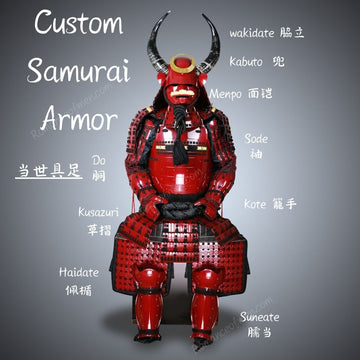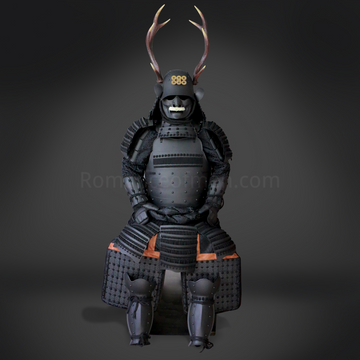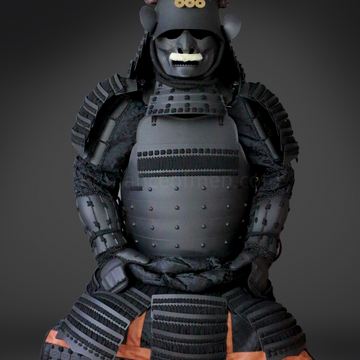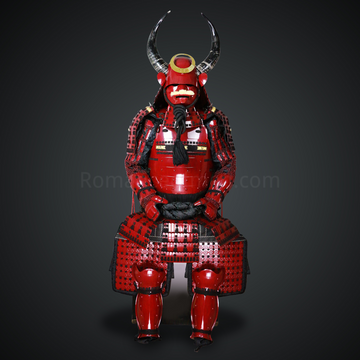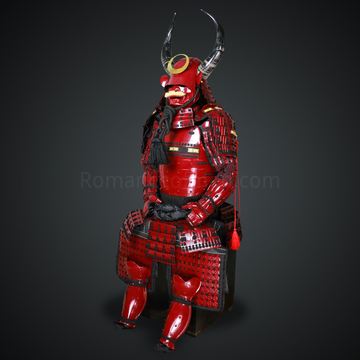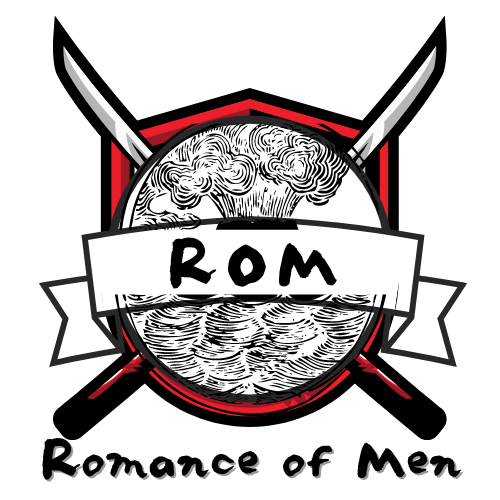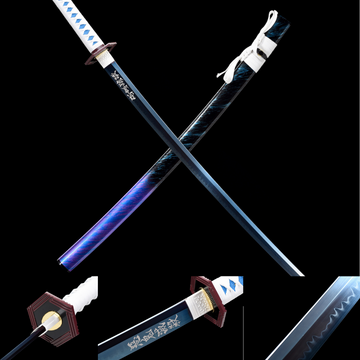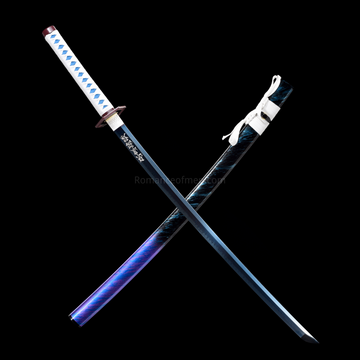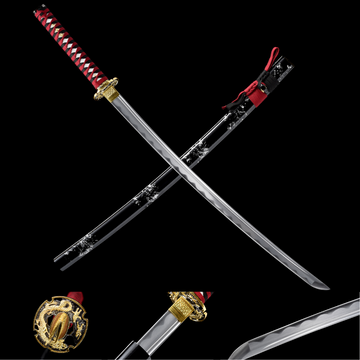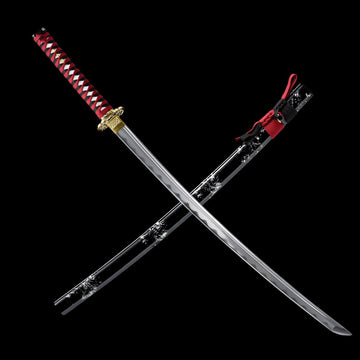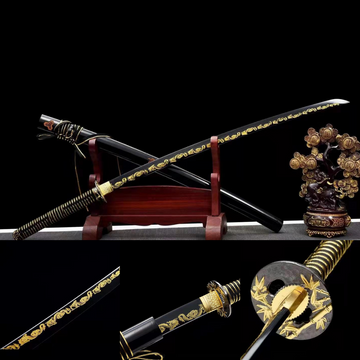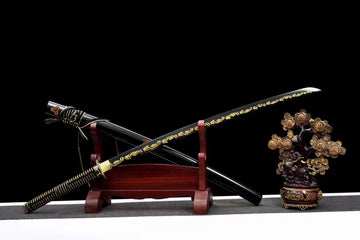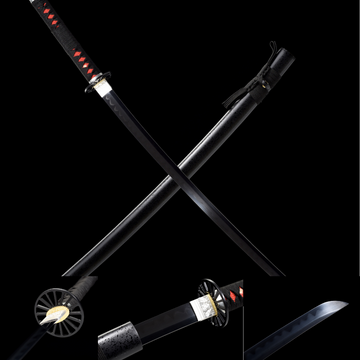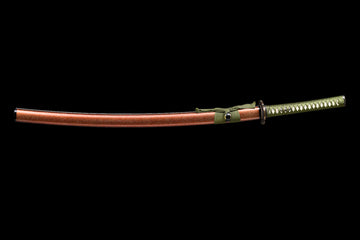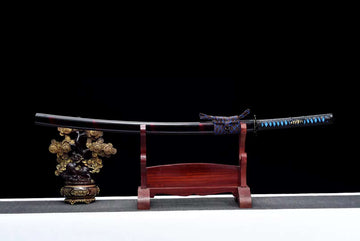Chinese Weapons : A Complete Guide to Understand The History, Material and Different Types
Introduction of Chinese Weapons:
China has documented over 2,000 major wars since the beginning of its civilization. This long history of warfare led to the development of many weapons. This article will give you better idea of the History of Chinese weapons and the major types of Chinese weapons.
Table of Content
History of Chinese Weapons:
The evolution of Chinese weapons spanned from primitive societies to feudal society. The development of Chinese warfare shares some similarities with Japanese warfare. It began with noble warriors fighting on horseback using bows, then infantry warfare became the dominant form of battle. Accordingly, the weapons they used evolved as well. There are many weapons existed since China's Stone age, in this article we'll focus on the most typical ones in each key dynastic。
Shang-Zhou period to the Spring and Autumn Era (c. 1600–476 BCE):

The major form of warfare of this time was chariot battles, chariot is called Zhanche 战车 in Chinese. Each war chariot carried three warriors: The central figure was the charioteer (Yuzhe 御者), driving the four-horse-drawn single-shaft chariot. On the left stood the "Chariot Commander" (Jia Shou 甲首), wielding a bow for ranged attacks while directing both the chariot crew and accompanying infantry. The right position was occupied by the "Combat Guard" (Rong You 戎右), armed with long-hafted dagger-axes (Ge 戈), halberds (Ji 戟), or short swords for close combat and chariot maintenance.
Battles unfolded in three clear steps: First, archers fired arrows during charges. Then, warriors fought with long weapons when chariots clashed. Finally, if chariots broke down, fighters switched to swords and shields for close combat. Thus, the major weapons were long range weapons like bronze dagger-axes (Ge 戈) and halberds ((Ji 戟), whose long reach (usually 3 meters long, 118 inches) proved ideal for sweeping attacks from laterally aligned chariot phalanxes. Though secondary to polearms, bronze swords and composite bows served crucial supporting roles, their status reflecting the era's emphasis on ritualized, formation-based warfare.
Warring States to Han Dynasty (475 BCE–220 CE):

The rise of infantry and cavalry during the Warring States period gradually phased out chariot warfare, a dominant system for over a thousand years. Advances in iron smelting led to popularity of weapons like the ring-pommel saber(HuanShouDao环首刀) —a narrow, straight-bladed sword optimized for slashing from horseback. Unlike brittle bronze swords, these sabers could cleave through leather armor repeatedly without dulling, even at high speeds.
At the same time, the mass production of repeating crossbows (Han-era stirrup-mounted crossbows had ranges exceeding 400 meters) and the refinement of iron lamellar armor marked a shift from aristocratic duels to large-scale, coordinated warfare emphasizing attack and defense. The ring-pommel saber and crossbow became the mainstream weapons of this era, reflecting the new priorities of mobility, durability, and mass combat.
Wei-Jin, Northern and Southern Dynasties to Sui-Tang Periods (3rd–10th centuries CE):

This era saw cavalry dominate warfare. Heavy cavalrymen wielded mashuo (马槊)—a type of armor-piercing lances with conical spearheads up to 50 cm long—capable of piercing through three layers of armor. Cavalry-centric strategies shaped weapon development: the mashuo and long spears (长枪) served as primary polearms, while infantry used modao (陌刀extra-long two-handed dao) and Bushuo (步槊infantry spear) to counter armored enemy. Mace-like armor-breaking weapons also gained popularity. This period prioritized heavy cavalry charges and specialized anti-armor tools, reflecting the intensifying clash between mobility and protection on the battlefield.
Song to Yuan Dynasties (10th–14th centuries CE):

The Song Dynasty, lacking strong cavalry, in order to counter Mongol horsemen they designed and mass-produced strong crossbows like the Shenbi Nu (神臂弩 "Divine Arm Crossbow"). This engineering marvel could shoot 370 meters, required 75 kg of force to draw, able to pierce the scaled armor of the Liao Iron Hawk cavalry.
Song-Yuan conflicts spurred weapon diversification: curved sabers from steppe nomads were adapted alongside domestic designs. Most revolutionary was the systematic use of gunpowder—poison-smoke bombs choked enemies with toxic fumes, and thunderclap bombs (震天雷 early grenades) exploded via rapid combustion, expanding thousands of times in volume. These innovations marked warfare's shift from cold weapons to firearms.
Ming to Qing Dynasties (1368–1912 CE):

The Ming Dynasty (1368–1644) saw significant advancements in firearms, including the elite Firearm Battalion (Shenji Ying) specializing in matchlock guns and cannons. While traditional arms like swords and spears remained in use, Ming blades adopted curved designs (Sori) inspired by Japanese katana craftsmanship, departing from earlier straight-bladed styles.
By contrast, the Qing Dynasty (1644–1912) regressed in firearms development due to conservative government policies. Emphasis returned to traditional arms: composite bows for mounted archery and Qing-era sabers (清刀) with distinct broad, slightly curved blades. Though some firearms from Ming dynasty were still used, Qing military prioritized mobility and archery, reflecting Manchu traditions over technological innovation.
Material of Chinese Weapons:
Bronze Weaponry in Ancient China:
As early as 5,000 years ago, China began making weapons from bronze. Pure copper is soft and need to add tin to enhance hardness. Ancient metallurgists developed precise copper-tin ratios for different weapons:
Axes: 83% copper, 17% tin
Polearms (spears/lances): 80% copper, 20% tin
Blades: 75% copper, 25% tin
Arrowheads: Tin content reached 28% for maximum piercing hardness
If a sword is too soft, it can’t stay sharp or deal damage. But if it’s too hard, it becomes brittle and snaps easily. To resolve this, Chinese craftsmen made the sword's spine from softer bronze and fitted harder bronze onto the blade edges. This way, when the sword was struck, the softer spine soaked up the force to prevent breaking, while the harder edges stayed sharp to cut effectively. This method is similar to the Japanese swordmaking techniques that layered steels with different carbon content on their blades.
Iron Weaponry in Ancient China:
Iron, compared to softer copper, produced tools and weapons that were less prone to deformation and more durable. While adding tin could increase the hardness of bronze, this improvement came at the cost of reduced toughness—like glass, high-tin bronze easily shattered under intense impact, a fatal flaw for armor and weaponry.
China’s iron smelting evolved through three stages:
Early Stage (Shang-Zhou, c. 1600–256 BCE):
Block-smelting method: Iron ore was reduced at low temperatures (~1200°C) to produce porous "sponge iron," which required repeated forging to remove impurities. The resulting iron had low hardness (HB 120–150).
Post-Warring States Breakthrough (after 5th century BCE):
Cast iron smelting: High-temperature furnaces (1300°C) produced molten pig iron directly. Through annealing and decarburization, this brittle cast iron was transformed into malleable wrought iron, boosting productivity by tens of times.
Han Dynasty to Northern-Southern Dynasties (202 BCE–589 CE):
Puddling process: Controlled carbon content enabled steel production.
Composite forging method (灌钢法): Layered forging of pig iron and wrought iron created steel with hardness exceeding HRC 55 and tensile strength over 800 MPa.
Though the Qin Dynasty (221–206 BCE) still relied mainly on bronze weapons, the Western Han Dynasty (202 BCE–9 CE) achieved large-scale iron production. From this point onward, iron completely replaced bronze as the dominant material for military and everyday tools.
Major Types of Chinese Weapons
Dao刀
Chinese Dao are single-edged sword, primarily designed for chopping and slashing like Machete, with over thousands years history—from straight-edged bronze blades in ancient times to practical combat weapons in the modern era. Here are some famous Chinese Dao:
Huan Shou Dao (环首刀 Ring-Pommel Saber, Han Dynasty, 202 BCE–220 CE):

Primary short weapon of Han infantry. Straight, single-edged blade with a distinctive metal ring pommel, looks similar to Ninjato in Japanese swords. Optimized for slashing, it was very effective against Xiongnu cavalry and represents the typical design of early Chinese blades.
Mo Dao (陌刀 Tang Dynasty, 618–907 CE):
A double-edged, long-hafted "horse-chopping saber" wielded with both hands. Exclusively issued to elite Tang troops, it specialized in countering armored cavalry. The Tang Liu Dian (Tang administrative code) describes its power as "slicing through warhorses like cutting grass." However, its complex forging process and high cost led to its gradual disappearance from battlefields.
Tang Hengdao (唐横刀 Tang Dynasty, 618–907 CE):

A single-edged, straight-bladed waist saber crafted with sandwich-forged steel—a laminated steel construction that balanced flexibility and hardness. Lightweight yet tough, it served as a standard close combat weapon for Tang soldiers. Its advanced metallurgy is confirmed by surviving examples in Japan's Shōsōin Repository, showcasing the Tang blade's influence on early Japanese sword making, most believed it is the earliest type of Japanese sword, the Chokuto.
Miao Dao (苗刀 Ming Dynasty, 1368–1644 CE):

A long, slender, slightly curved blade wielded one or two handed, looks similar to the Japanese Tachi. Could be used like a saber or spear, it was listed by general Qi Jiguang in Ji Xiao Xin Shu (New Treatise on Military Efficiency) as essential gear for Ming forces againest Japanese pirates (wokou). Its hybrid design—optimized for both slashing and thrusting—later transitioned into a martial arts practice weapon, preserving Ming-era combat principles in Chinese swordsmanship traditions.
Yanling Dao (雁翎刀 Qing Dynasty, 1644–1912 CE):

A saber with a distinctive upward-curved tip resembling a goose feather (雁翎刀), featuring a fuller (blood groove) along the blade to reduce weight while maintaining strength. Designed for versatility—balanced for both chopping and thrusting—it became the standard sidearm of the Eight Banners Army.
Dadao (大刀, 19th century )

A thick, heavy-headed double handed Dao, forged locally by blacksmiths using scrap metal due to wartime steel shortages. The weight of the blade makes it a great heavy target cutter.
剑 Jian
Much like the katana in Japanese culture, the sword (剑Jian) also holds profound cultural significance in China. As a symbol of Confucian ideals—embodying nobility, integrity, and moral discipline—it transcended its battlefield role to become a ceremonial accessory and status marker for scholars and nobles.
Bronze Sword (QingtongJian青铜剑):

A straight, double edged thrusting sword cast from copper-tin alloy (15–25% tin) in ancient China. Its structure comprised a blade, handle, and guard. Early variants were short (20–40 cm during the Shang-Zhou period, c. 1600–256 BCE), evolving into longer blades (50–95 cm) by the Spring and Autumn to Warring States periods (770–221 BCE). Bronze swords served both combat and ceremonial roles: shorter Shang-Zhou versions were primarily ornaments for noble during chariot battles. After iron weapons emerged in the Qin-Han era (221 BCE–220 CE), bronze swords retreated to ceremonial use, symbolizing authority rather than combat utility.
Han Jian (汉剑, Han Dynasty Sword):

The Han Jian was a remarkable design of ancient Chinese steel weaponry, evolving across the four-century of the Han dynasties. It preserved the structural of bronze swords, adding advanced steel forging technology. Primarily made of iron, its blade was straight and symmetrical, often featuring a four-sided diamond cross-section, with lengths typically exceeding one meter. It balanced both flexibility and sharpness.
Qingtong Yue (青铜钺 Bronze Axe):

A wide-bladed chopping axe cast from copper-tin alloy (15–25% tin) during the Shang-Zhou period (c. 1600–256 BCE). Its flat fan-shaped or trapezoidal design featured a wide, curved blade edge, with some examples adorned with taotie (animal mask) motifs or pierced openwork designs. Yue served two purposes: as an armor-breaking weapon in chariot battles, but more crucially as a symbol of royal authority. Primarily wielded by Shang-Zhou nobility, regional rulers, and elite charioteers, it was phased out of battlefiled by the Warring States period (475–221 BCE) as iron weapons became widespread.
Song Dynasty Great Axe (宋朝大斧):

Forged during the Northern and Southern Song dynasties (960–1279 CE) using puddling steel (炒钢法) or co-fusion steelmaking (灌钢法), this armor-piercing axe featured a long shaft (1.8–2.2 meters) paired with a broad blade (about 30 cm wide). The blade often incorporated hook-like protrusions to snag and dismantle armor. Its primary function was countering Jurchen and Mongol heavy cavalry, leveraging sheer chopping force to crush lamellar armor and dismount riders.
Bishou (匕首 Dagger):

A short, sharp-edged dagger designed for concealment and portability. Resembling a sword in form but significantly shorter, bishou date back to the Neolithic period with early examples crafted from stone or bone. Over time, materials and techniques evolved—stone and bone gave way to bronze and iron/steel, enhancing edge sharpness.
A legendary example is the Yuchang Sword (鱼肠剑, "Fish-Intestine Sword"), used by the assassin Zhuan Zhu in the late Spring and Autumn Period (6th–5th century BCE) to kill King Liao of Wu. The dagger was hidden inside a roasted fish and drawn abruptly during the meal to strike the fatal attack.
Bishou was mainly used for close combat, personal defense, or assassination, daggers were rarely used in battlefields. In comparison, The Japanese Tanto might be more common to used in battlefield because Japanese soldiers like to use it to stab into the gaps of Samurai armor.
Bian (鞭Chinese Battle Flail):

A battlefield flail forged from iron or bronze, characterized by multi-segmented, bamboo-like sections (60–100 cm long) with circular or octagonal cross-sections. Designed to counter heavy armor, it featured a hole near the guard for attaching a wrist strap to prevent slipping. Some variants included a spiked tip for piercing armor, enhanced through forging or steel-layered techniques. Primarily used from the Jin Dynasty (265–420 CE) to the Ming-Qing periods (1368–1912 CE), it combined blunt-force trauma with targeted armor penetration.
Jian (锏):

A blunt-force weapon forged from iron or bronze in ancient China, characterized by a quadrangular or octagonal prism-shaped rod (common length: 80–120 cm) with sharp edges but no blade. Some variants featured grooves to reduce weight. Like the battle flail (鞭), it was specialized for armor-piercing strikes, leveraging concentrated force to crush or penetrate lamellar armor.
Chui (War Hammer锤)

Chinese war hammers varied widely in form, from stone spheres (10 cm in diameter) to Song-Ming era bronze hammers with four-edged heads (60–80 cm long). Materials evolved from stone to bronze and later iron/steel, hammerheads typically weighed between 200–800 grams.. In combat, one-handed hammers often had wrist straps to prevent slip out of hand, Chui served as armor-crushing weapons due to their blunt force. By the Han Dynasty, they became secondary cavalry weapons.
Gun (棍 Staff)

Gun is one of the China's oldest cold weapons, the gun typically features a straight, long cylindrical rod (1.3–4 meters long) with a circular cross-section and a diameter optimized for a single-handed grip. Some variants include iron-reinforced tips or spiked ends. Though bladeless, its striking and sweeping attacks are still very effective. To this day, it remains a core training tool in Chinese martial arts.
Guandao (关刀 glaive)

The Guan Dao is a type of pole weapon with single edge blade (Dao), similar to a glaive, more accurately known as the "Yanyue Dao 偃月刀." China has this long handle dao since the Shang Dynasty. After the Han Dynasty, various dynasties developed their own distinct styles of long handle dao, many of which were used by warriors in cavalry combat. Yanyuedao is the most famous design, because it was believed used by Guanyu, a legendary general in China.
The design of the "Yanyue Dao" can be traced back to the Song Dynasty. This weapon is distinguished by its long handle and heavy blade, with the tip of the blade subtly curving inward to form an elegant quarter-circle shape. The back of the blade features a unique split that creates a gap, possibly designed to trap or entangle an enemy’s weapon, enhancing its practicality in battle. In Japan, the shape of the naginata closely resembles that of the Chinese Guan Dao.
Mao (矛 Spear)

The Mao was the most iconic thrusting polearm in ancient China, composed of a spearhead and a long shaft. Early spearheads were willow-leaf-shaped, later evolving into narrow iron blades, some featuring blood grooves or barbs. Shafts initially used a hardwood core wrapped with bamboo strips, later replaced by solid wood like ash.
In Chinese, qiang (枪), mao (矛), and shuo (槊) all correspond to the English term "spear," differing mainly in naming conventions and dimensions across dynasties. Much like the Japanese yari, the spear has been a major weapon across many dynasties. It's a common misunderstanding that shorter weapons, such as the katana, were the primary weapon on the battlefield.
Ge (戈):

Ge is a uniquely Chinese horizontal-bladed polearm designed for hooking and pecking attacks. It consisted of a bronze or iron ge head mounted on a wooden shaft (up to 3 meters long for Warring States chariot warfare). Ge were mainly made of bronze, it was the mainstream weapon from Shang-Zhou to Warring States periods (c. 1600–221 BCE). By the late Warring States era, it merged with spears (矛) to form the ji (戟, halberd) and faded from combat. By the Han Dynasty (202 BCE–220 CE), it transitioned to ceremonial use.
Ji (戟):

A unique composite polearm in ancient China, evolved from the combination of the Ge (戈, hooking blade) and Mao (矛, spear). Functionally, it integrated multiple attack modes: thrusting, hooking, pecking, and slicing, making it especially effective against heavy armor. Ji was popular from the Spring and Autumn period (770–476 BCE) to the Wei-Jin era (220–420 CE), its combat role declined after the Tang Dynasty (618–907 CE), supplanted by the more versatile long spear (枪).
Gong (Bow弓箭)

Chinese bows evolved over thousands of years. Their forms progressed from Neolithic single-piece bamboo/wood straight bows to Shang-Zhou willow-leaf-shaped bronze arrowheads, then Han Dynasty iron trilobate armor-piercing arrowheads, culminating in the iconic Ming-Qing long-limbed recurved composite bows.
Beyond battlefield utility, archery (射) was one of the Six Arts of the ancient Chinese gentleman, shows its cultural significance in Chinese history. Japan, deeply influenced by Chinese culture, also places great value on the bow (yumi). Samurai are expected to excel in both horsemanship and archery.
Nu (弩Crossbow)

The Chinese crossbow consists of a stock (弩臂), bow (弩弓), and a bronze or iron trigger mechanism (弩机). It used various drawing methods, including arm-drawing (臂张, Warring States period), foot-stirrup (脚踏, Han Dynasty waist-drawn crossbow), and winch mechanisms (绞盘, Song Dynasty arcuballista).
As the most ingeniously designed range weapon before the firearm era, the Chinese crossbow integrated mechanical energy storage with ergonomic design. Especially the crossbows from Song Dynasty:
Shenbi Crossbow (神臂弓): Featuring an ash wood stock, it achieved a range of 372 meters and could penetrate heavy armor.
Triple-Bow Arcuballista (三弓床弩): Operated by 100 soldiers, it launched large arrows over 1,500 meters (千步, "thousand paces"), making it one of the most effective long-range weapon of its time.
Firearms:火器:

Firearms in ancient China evolved from the Song to Qing dynasties, many firearms were invented and ahead of the world. During the Ming Dynasty, China imported and learned about firearms from the West. Just as Japanese infantry (Ashigaru) widely used tanegashima guns, the Ming army also extensively adopted firearms.
However, in Qing Dynasty, their policy of "prioritizing horseback archery" led to set back of firearm developments. By the Opium Wars, Qing forces still used solid shot and black powder, lagging two centuries behind Western explosive shell technology.
A representative example of Chinese firearm was the Ming-era Triple-Barreled Arquebus (三眼铳, San Yan Chong)—a transitional weapon between cold weapons and firearms. Its design featured three wrought-iron barrels (30-40 cm long, 1.5-2 cm caliber) arranged in a triangular formation, mounted on a 1.5-meter wooden shaft. Some variants included an iron spike or spearhead at the base, enabling both ranged and melee combat. Widely used by northern frontier troops and Liaodong cavalry during the Wanli to Chongzhen reigns (1573-1644), it was deployed against Mongol cavalry and the Later Jin Eight Banners.
